Gas Pipeline Response to Underlying Straight-Wall Arch Tunnel Construction
Abstract
:1. Introduction
2. Project Overview
2.1. Project Outline
2.2. Project Geological Conditions
2.3. Field Construction Scheme
2.3.1. Grouting Reinforcement Scheme
2.3.2. Tunnel Excavation Scheme
3. Analysis of Finite Element Numerical Simulation
3.1. Establishment of Numerical Model
3.1.1. Model Establishment
3.1.2. Calculation Parameters
3.2. Numerical Simulation Scheme
3.3. Control Indexes
3.4. Results of Numerical Simulation
3.4.1. Types of Grouting Reinforcement
3.4.2. Grouting Reinforcement Range
3.4.3. Step Distance of Tunnel Excavation
4. Field Monitoring Data Analysis
4.1. Field Monitoring Scheme
4.2. Analysis of Monitoring Results
4.2.1. Gas Pipeline Settlement
4.2.2. Settlement of Tunnel Vault
4.3. Comparison of Simulation and Measurement Results
5. Conclusions
- (1)
- The application of the advanced grouting reinforcement measure is conducive to the control of gas pipeline settlement, with a broader range of grouting reinforcement bringing about a smaller settlement of the gas pipeline. Using the method of upper semi-section grouting reinforcement to prevent the grouting area from being too close to the gas pipeline, a grouting reinforcement range of 2.0 m was determined in this study, with a calculated maximum value of gas pipeline settlement being 18.23 mm.
- (2)
- The entrance and exit tunnels of the subway station are constructed with a straight-wall arch structural pattern, and the application of a double-side drift method in the construction can reduce the stress concentration of the lining, thus representing an efficient and sustainable method for tunnel construction. A smaller step distance of excavation brings about a smaller settlement of the gas pipeline. Under an excavation step distance of 8 m, the maximum settlement of the gas pipeline reached a value of 23.16 mm, which is higher than the control value. Therefore, it is appropriate to apply an excavation step distance of 6m on site.
- (3)
- With the application of the advanced grouting reinforcement method in the construction of the straight-wall arch tunnel, the use of the double-side drift method in the building of the tunnel body can effectively reduce the influence of crossing construction on the settlement of overlying gas pipeline. The measured maximum settlement of the gas pipeline reached a value of 18.46 mm, with the maximum settlement of the tunnel vault reaching a value of 22.86 mm. Both values are lower than the specified value of the control standard, indicating a successful application of the proposed deformation control measure in this project.
Author Contributions
Funding
Data Availability Statement
Acknowledgments
Conflicts of Interest
References
- Lin, C.G.; Huang, M.S.; Nadim, F.; Liu, Z.Q. Tunnelling-induced response of buried pipelines and their effects on ground settlements. Tunn. Undergr. Space Technol. 2020, 96, 103193. [Google Scholar] [CrossRef]
- Klar, A.; Marshall, A.M. Linear elastic tunnel pipeline interaction: The existence and consequence of volume loss equality. Geotechnique. 2015, 65, 788–792. [Google Scholar] [CrossRef]
- Klar, A.; Elkayam, I.; Marshall, A.M. Design oriented linear-equivalent approach for evaluating the effect of tunneling on pipelines. J. Geotech. Geoenviron. 2016, 142, 04015062. [Google Scholar] [CrossRef]
- Yu, J.; Zhang, C.R.; Huang, M.S. Soil–pipe interaction due to tunnelling: Assessment of Winkler modulus for underground pipelines. Comput. Geotech. 2013, 50, 17–28. [Google Scholar] [CrossRef]
- Klar, A. A Fourier-based elastic continuum solution for jointed pipeline response to tunneling. Tunn. Undergr. Space Technol. 2022, 119, 104237. [Google Scholar] [CrossRef]
- Wham, B.P.; Argyrou, C.; O’Rourke, T.D. Jointed pipeline response to tunneling-induced ground deformation. Can. Geotech. J. 2016, 53, 1794–1806. [Google Scholar] [CrossRef]
- Vorster, E.T.; Klar, A.; Soga, K.; Mair, R.J. Estimating the effects of tunneling on existing pipelines. J. Geotech. Geoenviron. 2005, 131, 1339–1440. [Google Scholar] [CrossRef]
- Ni, P.; Mangalathu, S. Fragility analysis of gray iron pipelines subjected to tunneling induced ground settlement. J. Geotech. Geoenviron. 2018, 76, 133–144. [Google Scholar] [CrossRef]
- Wang, J.Q.; An, J.T.; Zhang, S.Y.; Ge, R.Y.; Xie, Q.W.; Chen, Q.S.; Zheng, S.Z.; Ye, M.G. Numerical investigation and prediction of side-by-side tunneling effects on buried pipelines. Sustainability 2023, 15, 353. [Google Scholar] [CrossRef]
- Wang, G.; Fang, Q.; Du, J.M.; Wang, J.; Li, Q.M. Deep learning-based prediction of steady surface settlement due to shield tunnelling. Automat. Constr. 2023, 154, 105006. [Google Scholar] [CrossRef]
- Zhang, Z.G.; Huang, M.S. Boundary element model for analysis of the mechanical behavior of existing pipelines subjected to tunneling-induced deformations. Comput. Geotech. 2012, 46, 93–103. [Google Scholar] [CrossRef]
- Deng, H.S.; Fu, H.L.; Shi, Y.; Huang, Z.; Huang, Q.B. Analysis of asymmetrical deformation of surface and oblique pipeline caused by shield tunneling along curved section. Symmetry 2021, 13, 2396. [Google Scholar] [CrossRef]
- Li, W.; Zhang, C.P.; Zhang, D.L.; Ye, Z.J.; Tan, Z.B. Face stability of shield tunnels considering a kinematically admissible velocity field of soil arching. J. Rock. Mech. Geotech. 2022, 14, 505–526. [Google Scholar] [CrossRef]
- Zhang, C.P.; Han, K.H.; Zhang, D.L. Face stability analysis of shallow circular tunnels in cohesive-frictional soils. Tunn. Undergr. Space Technol. 2015, 50, 345–357. [Google Scholar] [CrossRef]
- Zhang, Z.G.; Zhang, M.X. Mechanical effects of tunneling on adjacent pipelines based on Galerkin solution and layered transfer matrix solution. Soils Found. 2013, 53, 557–568. [Google Scholar] [CrossRef]
- Shi, J.W.; Wang, Y.; Ng, W.C. Numerical parametric study of tunneling-induced joint rotation angle in jointed pipelines. Can. Geotech. J. 2016, 53, 2057–2071. [Google Scholar] [CrossRef]
- Zhao, D.P.; Wang, L.W.; Zhang, B.H.; Wen, S.X.; Li, D.; Wang, D.Y. Study on launch tunnelling parameters of a shield tunnel buried in pebble soil with existing pipelines base on discrete continuous coupling numerical method. Tunn. Undergr. Space Technol. 2022, 129, 104629. [Google Scholar] [CrossRef]
- Jiang, N.; Gao, T.; Zhou, C.B.; Luo, X.D. Effect of excavation blasting vibration on adjacent buried gas pipeline in a metro tunnel. Tunn. Undergr. Space Technol. 2018, 81, 590–601. [Google Scholar] [CrossRef]
- Xia, Y.Q.; Jiang, N.; Zhou, C.B.; Luo, X.D. Safety assessment of upper water pipeline under the blasting vibration induced by Subway tunnel excavation. Eng. Fail. Anal. 2019, 104, 626–642. [Google Scholar] [CrossRef]
- Ma, S.K.; Shao, Y.; Liu, Y.; Jiang, J.; Fan, X.L. Responses of pipeline to side-by-side twin tunnelling at different depths: 3D centrifuge tests and numerical modelling. Tunn. Undergr. Space Technol. 2017, 66, 157–173. [Google Scholar] [CrossRef]
- Ma, S.K.; Liu, Y.; Lv, X.L.; Shao, Y.; Feng, Y. Settlement and load transfer mechanism of pipeline due to twin stacked tunneling with different construction sequences. KSCE. J. Civ. Eng. 2018, 22, 3810–3817. [Google Scholar] [CrossRef]
- Shi, J.W.; Wang, Y.; Ng, W.C. Three-dimensional centrifuge modeling of ground and pipeline response to tunnel excavation. J. Geotech. Geoenviron. 2016, 142, 04016054. [Google Scholar] [CrossRef]
- Marshall, M.A.; Klar, A.; Mair, J.R. Tunneling beneath buried pipes: View of soil strain and its effect on pipeline behavior. J. Geotech. Geoenviron. 2010, 136, 1664–1672. [Google Scholar] [CrossRef]
- Zhang, X.; Cheng, H.; Xu, Y.J.; Li, H.L. A case study on performances of overlying pipelines due to shallow tunnels excavation in water-rich gravel ground. Ain. Shams Eng. J. 2022, 13, 101746. [Google Scholar] [CrossRef]
- Hou, Y.J.; Fang, Q.; Zhang, D.L.; Wong, L.N.Y. Excavation failure due to pipeline damage during shallow tunnelling in soft ground. Tunn. Undergr. Space Technol. 2015, 46, 76–84. [Google Scholar] [CrossRef]
- Li, X.G.; Wang, T.; Yang, Y. An investigation into the tunnel-soil-pipeline interaction by in situ measured settlements of the pipelines. Adv. Civ. Eng. 2020, 2020, 8850380. [Google Scholar] [CrossRef]
- GB 50911-2013; Code for Monitoring Measurement of Urban Rail Transit Engineering. China Architecture & Building Press: Beijing, China, 2013. (In Chinese)
- GB 50652-2011; Code for Risk Management of Underground Works in Urban Rail Transit. China Architecture & Building Press: Beijing, China, 2011. (In Chinese)
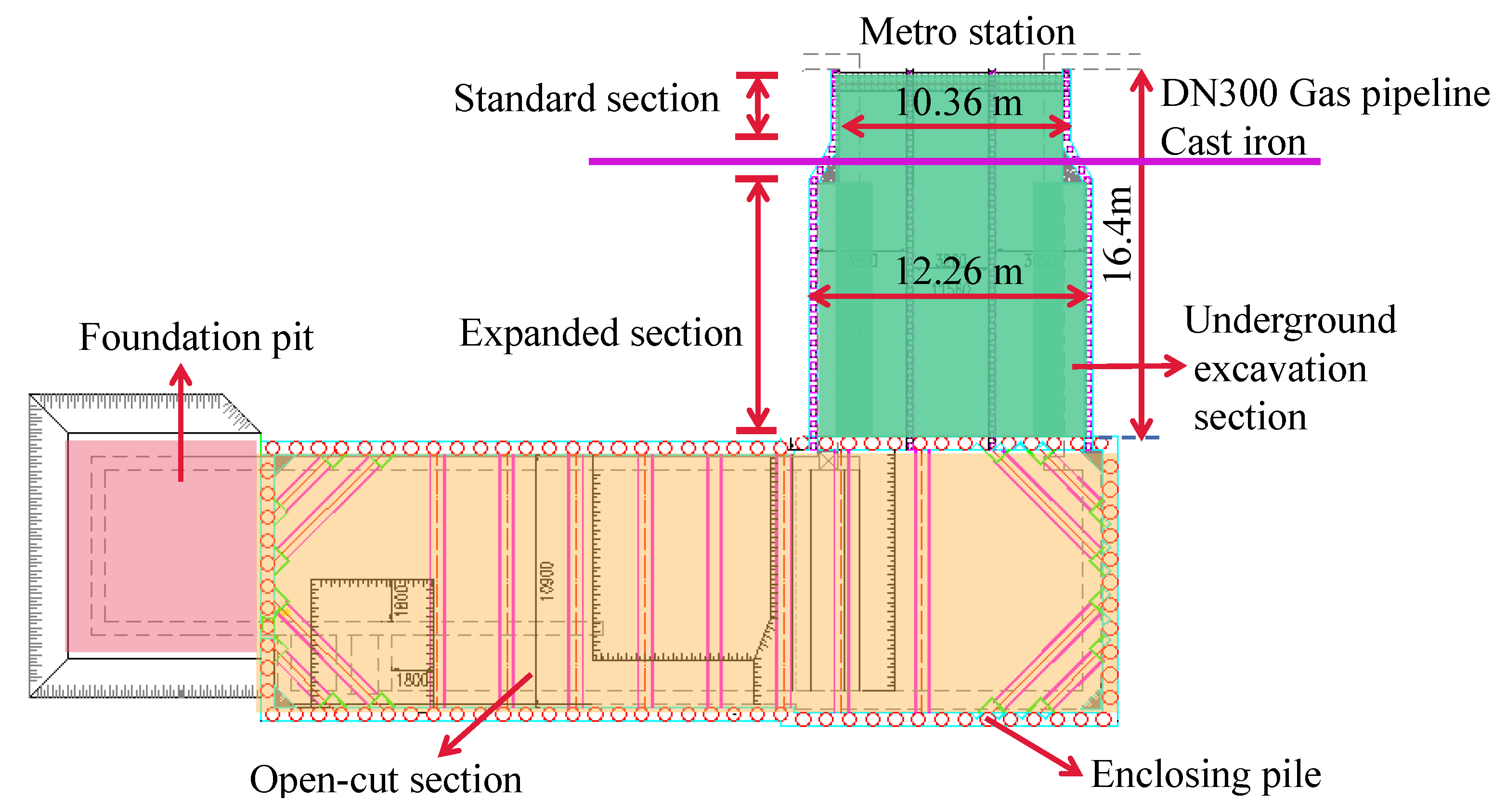

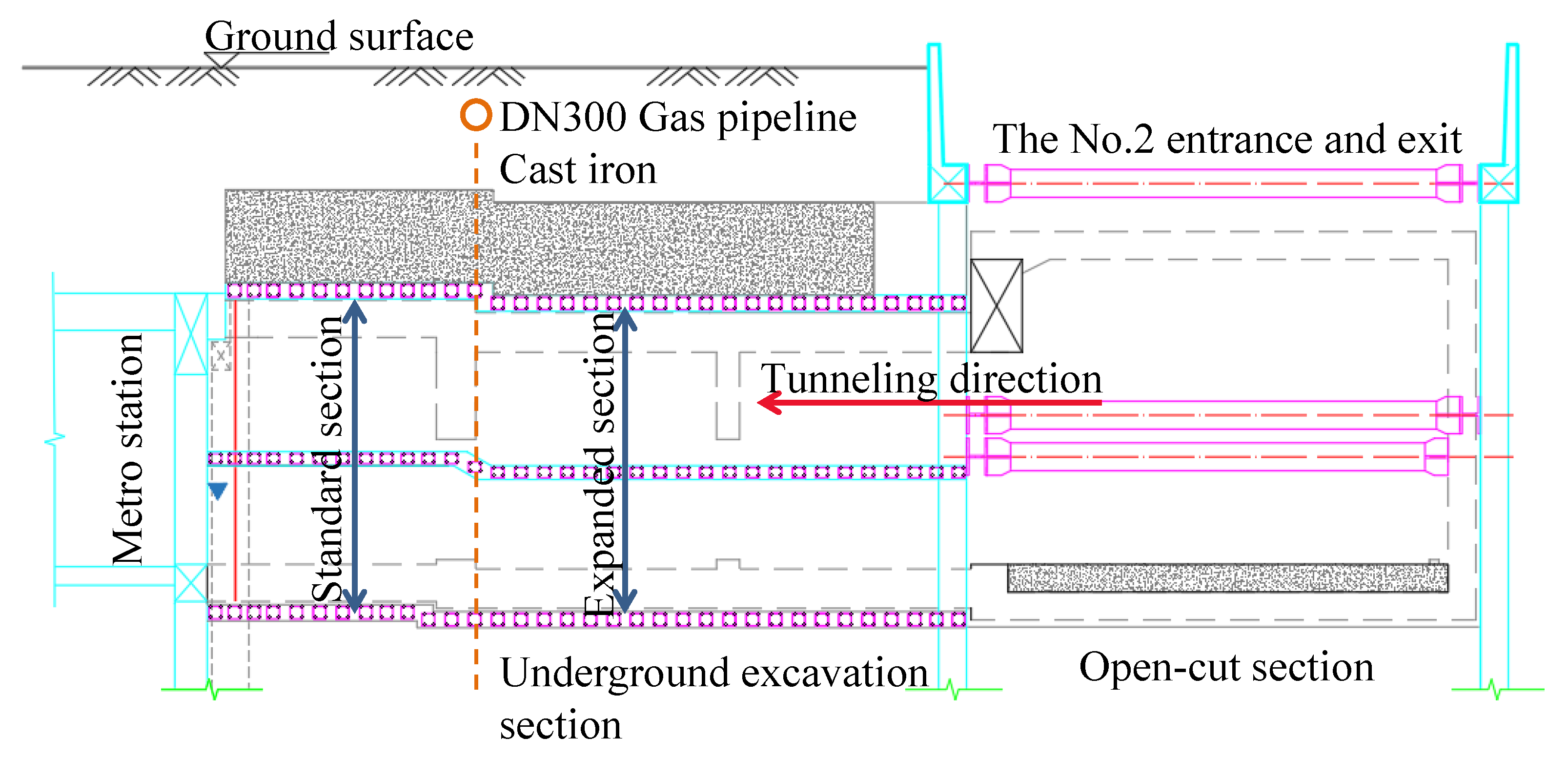

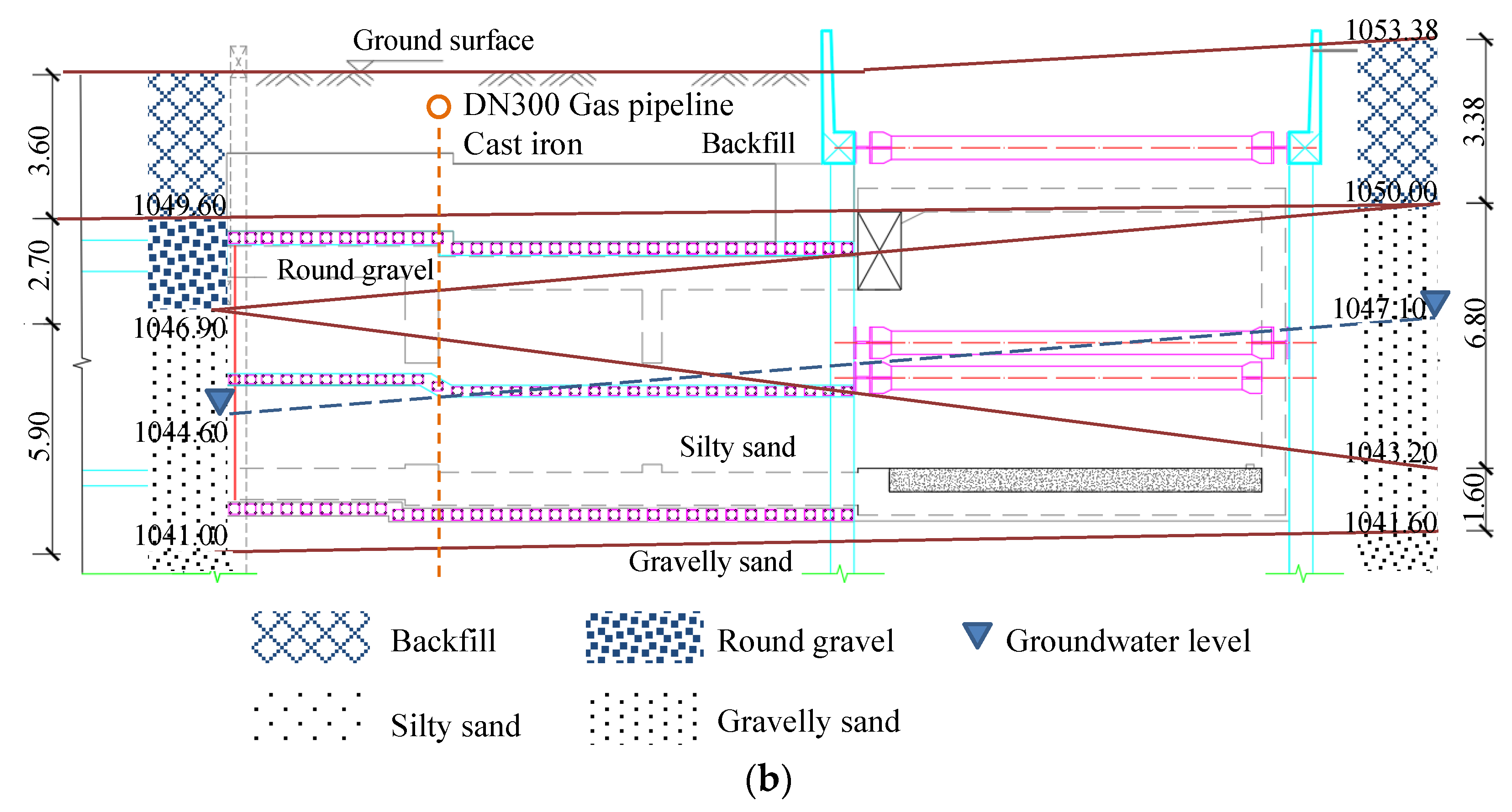
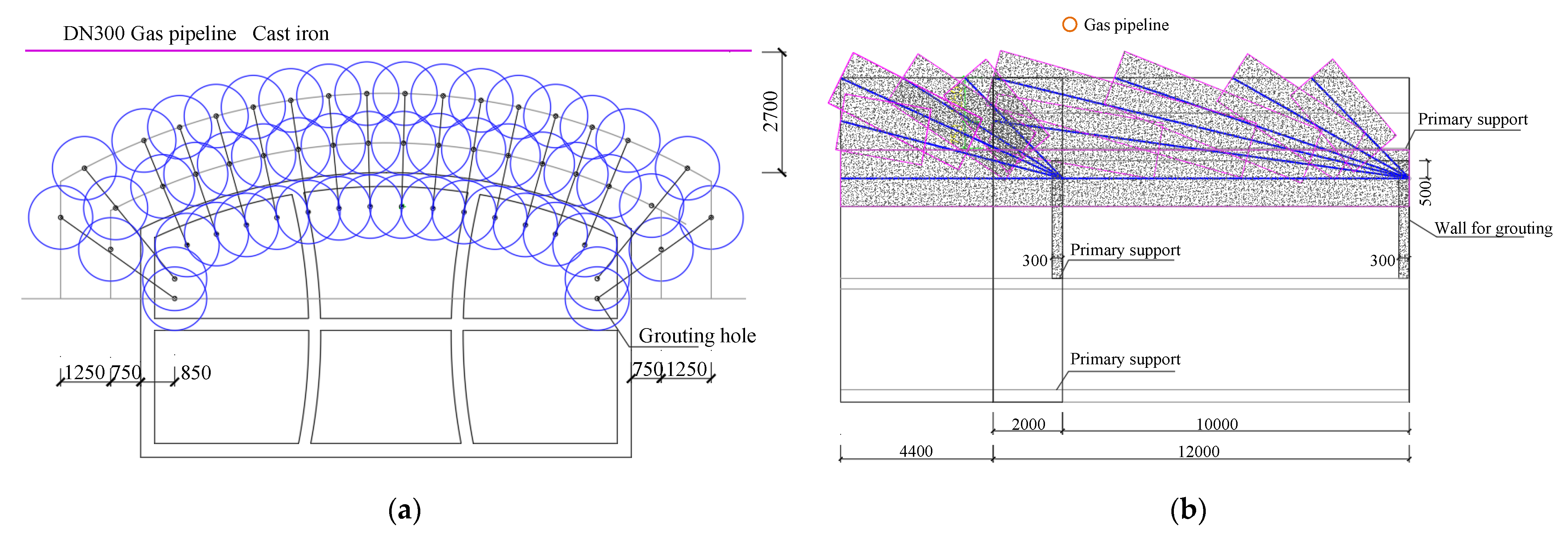

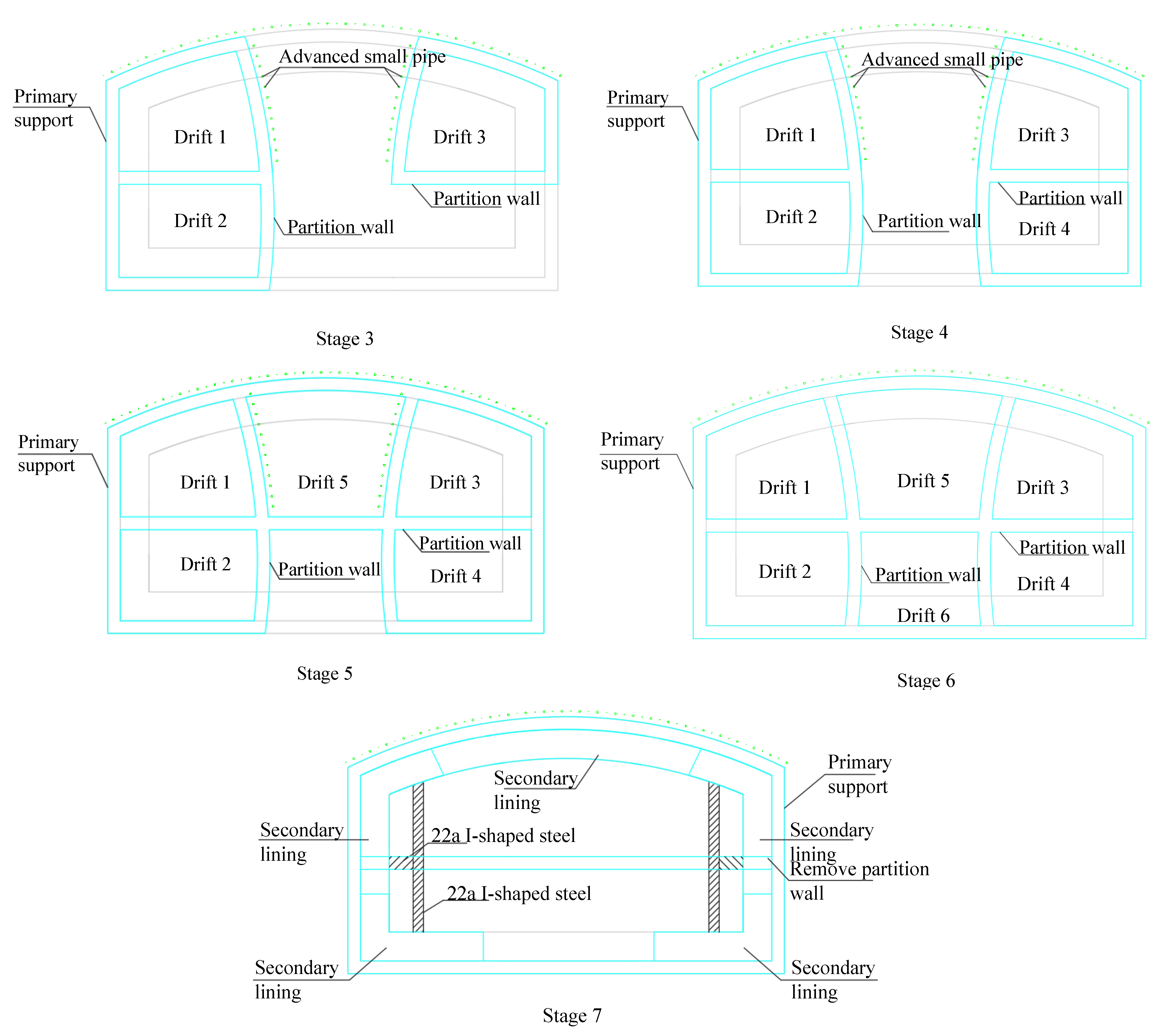
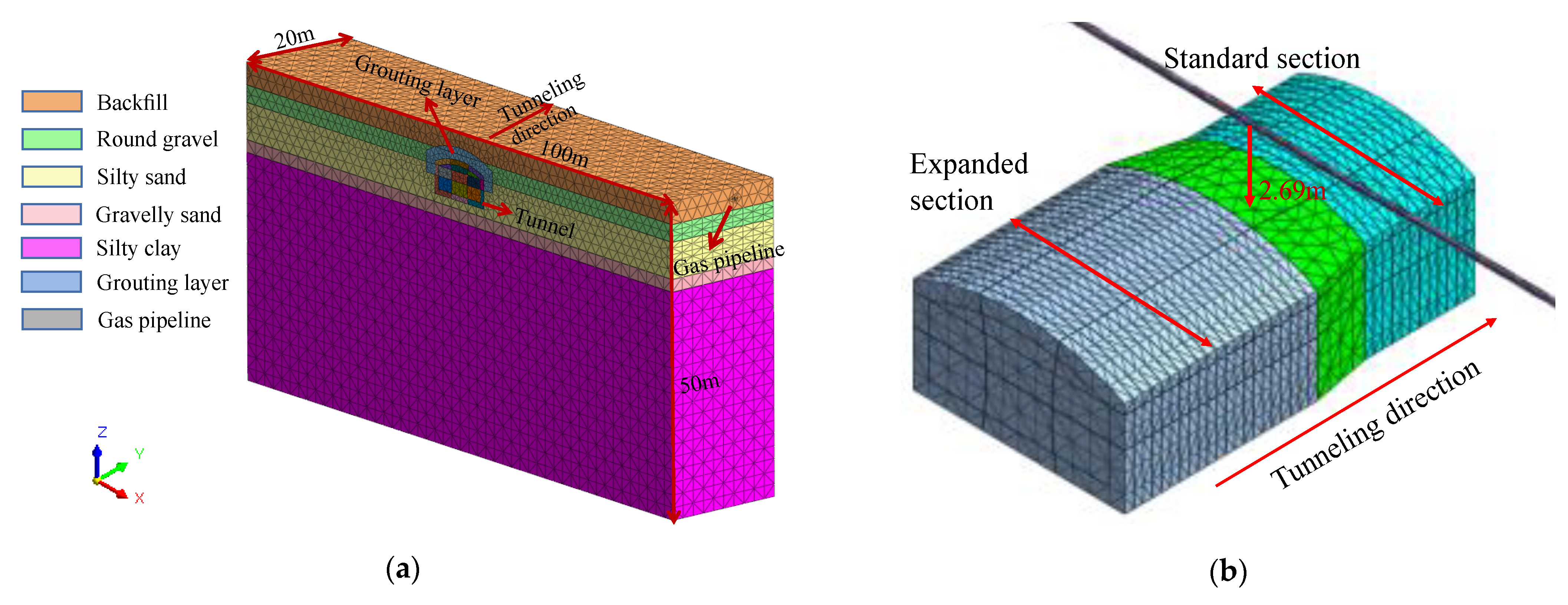

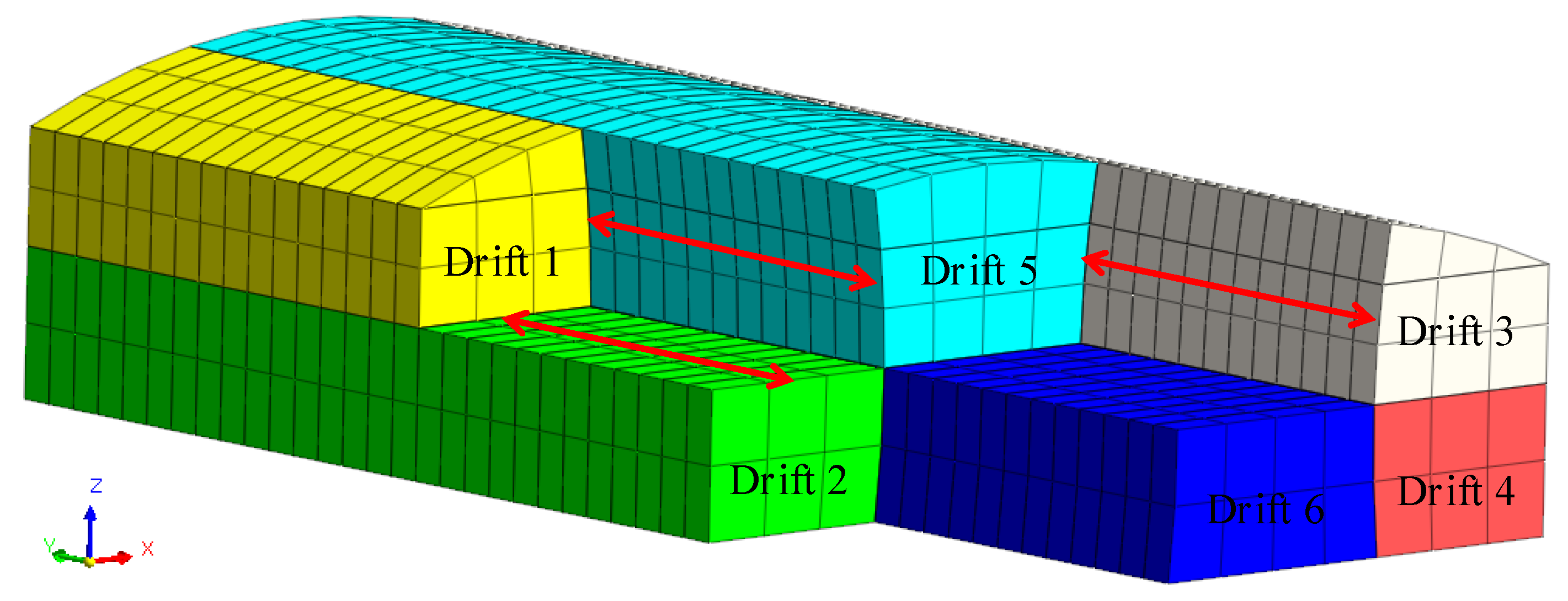
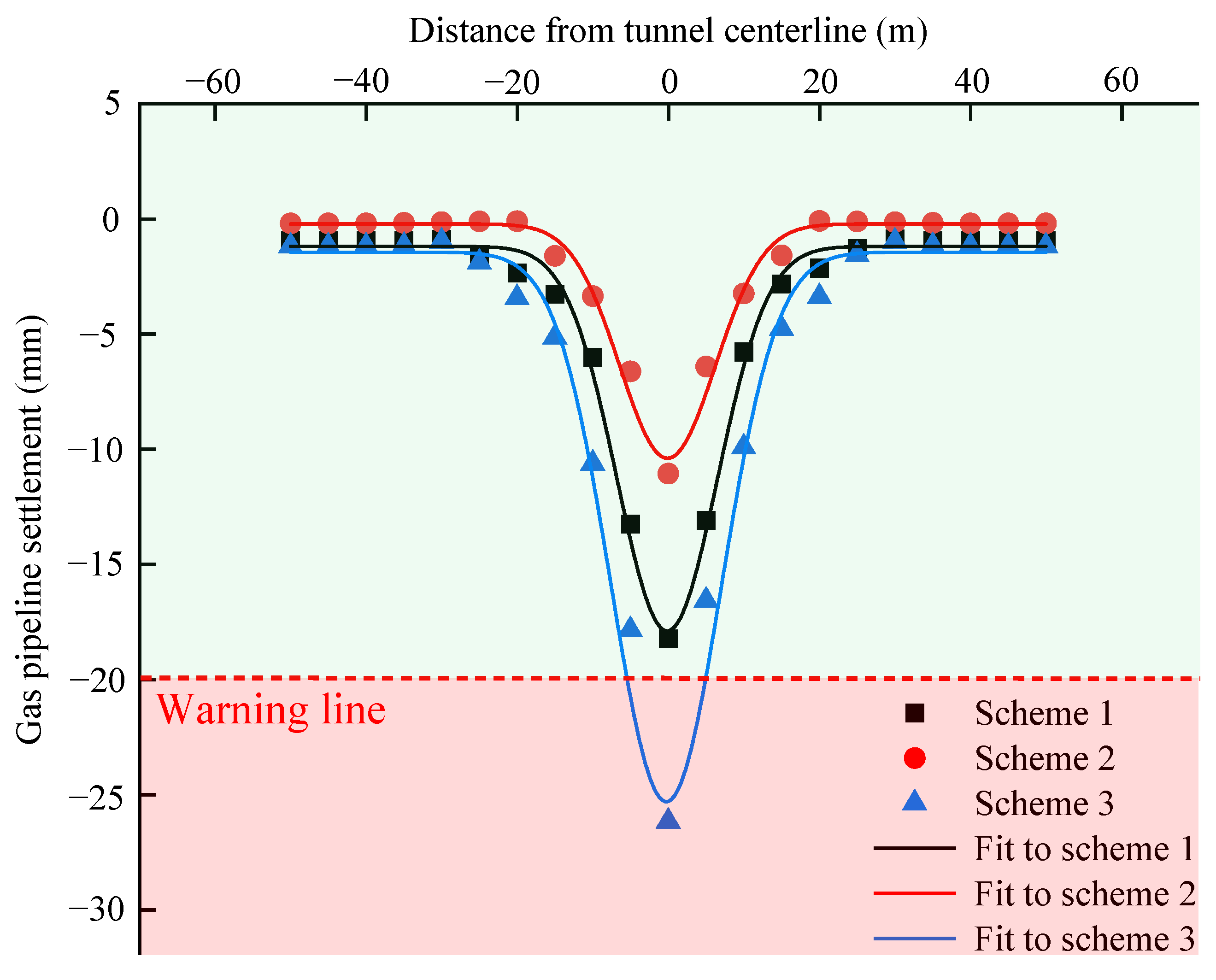
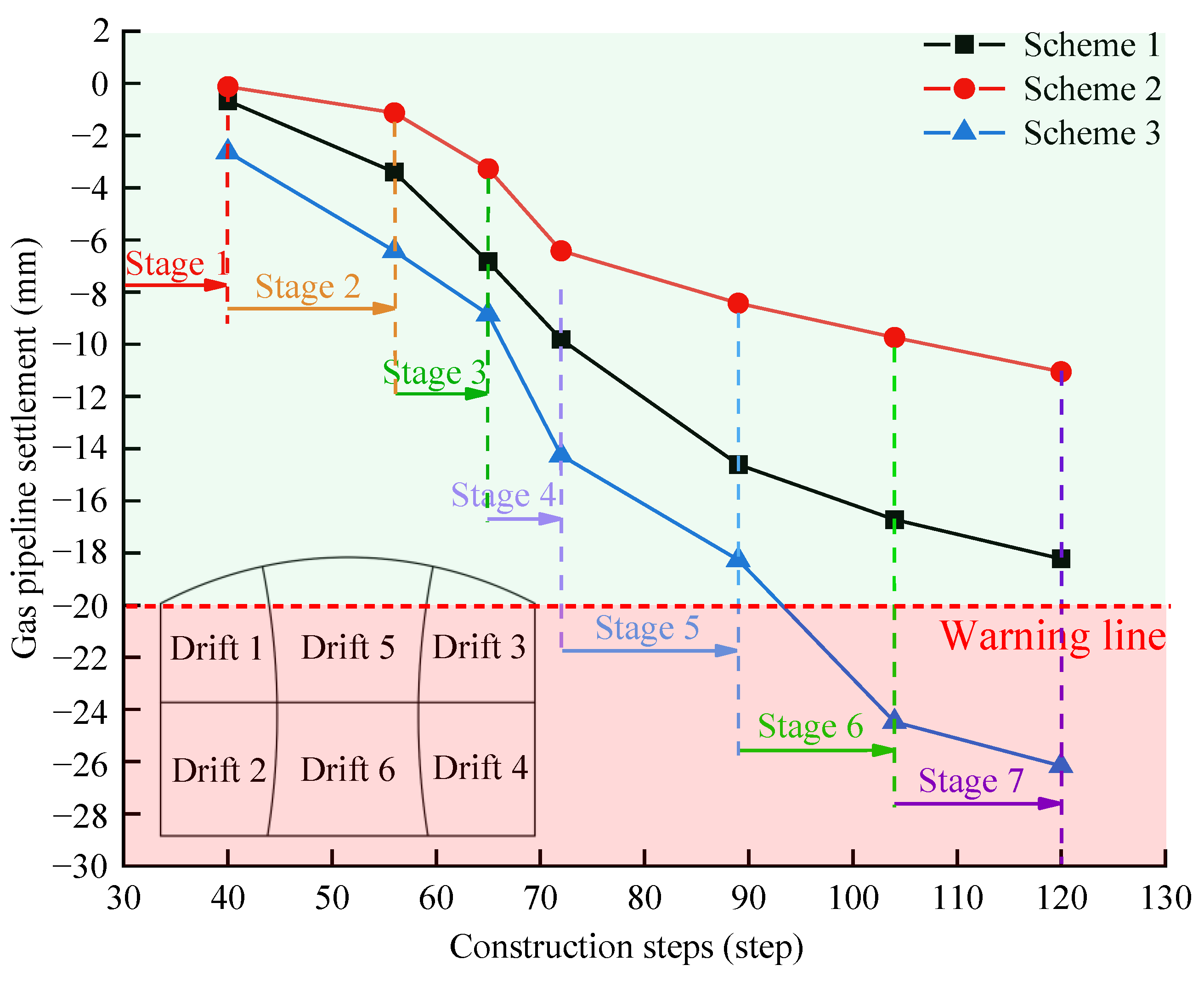
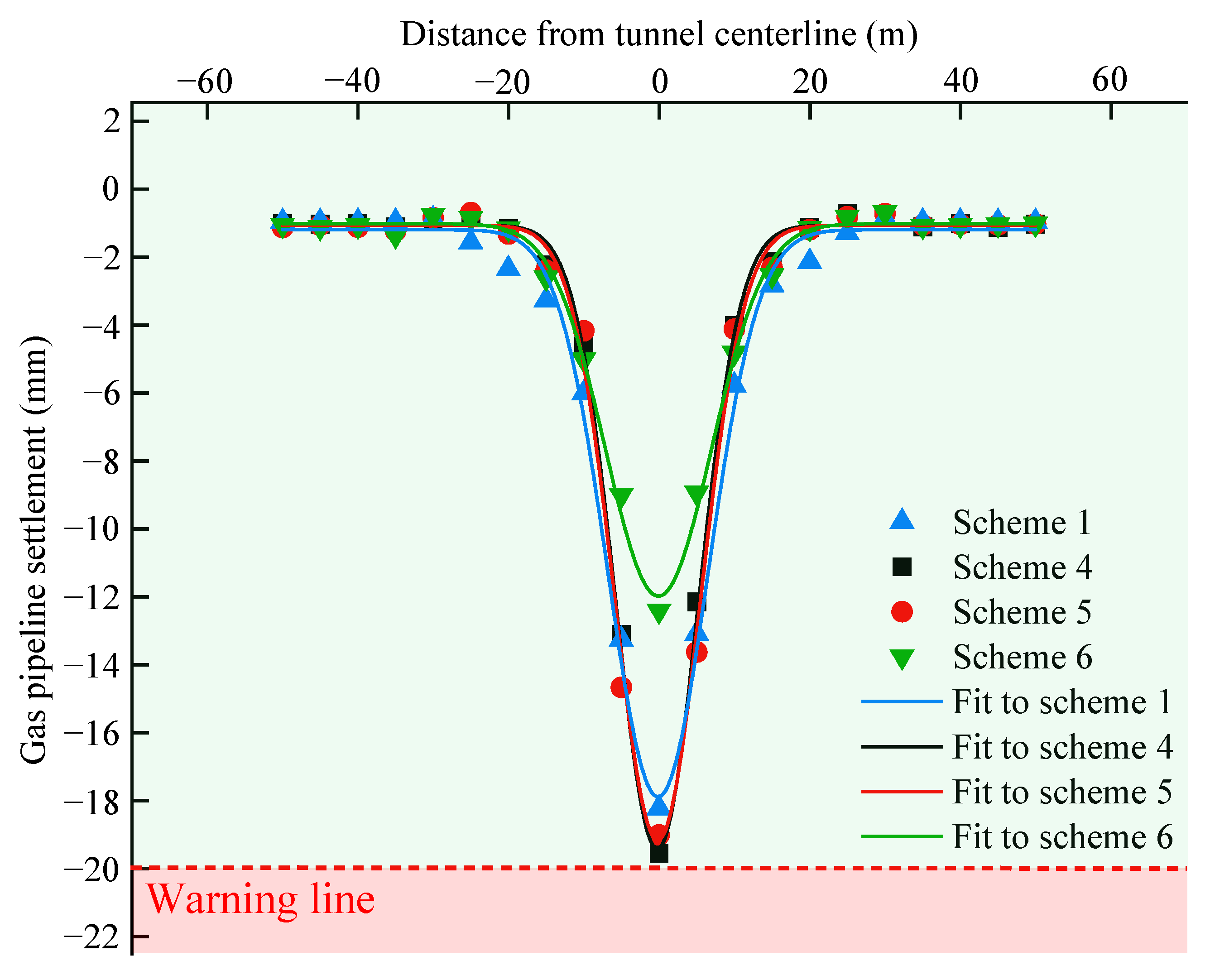

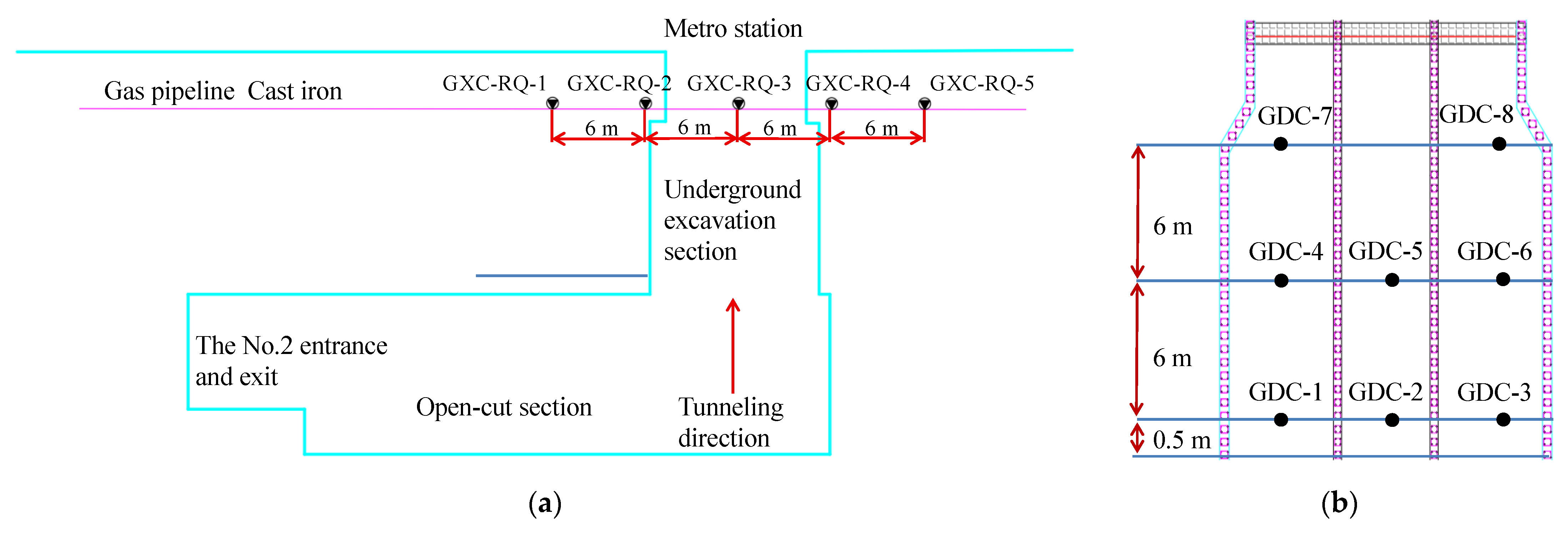

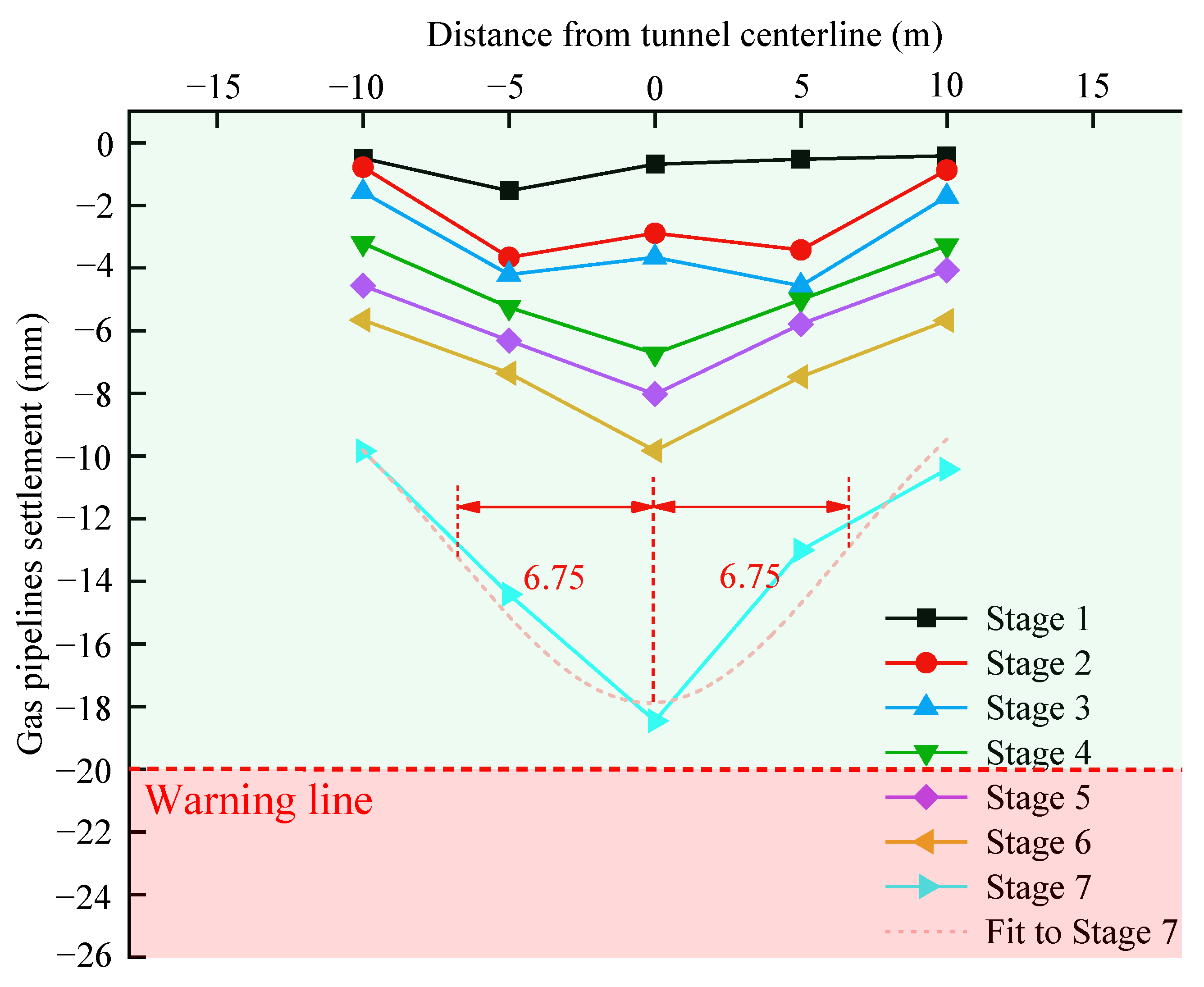

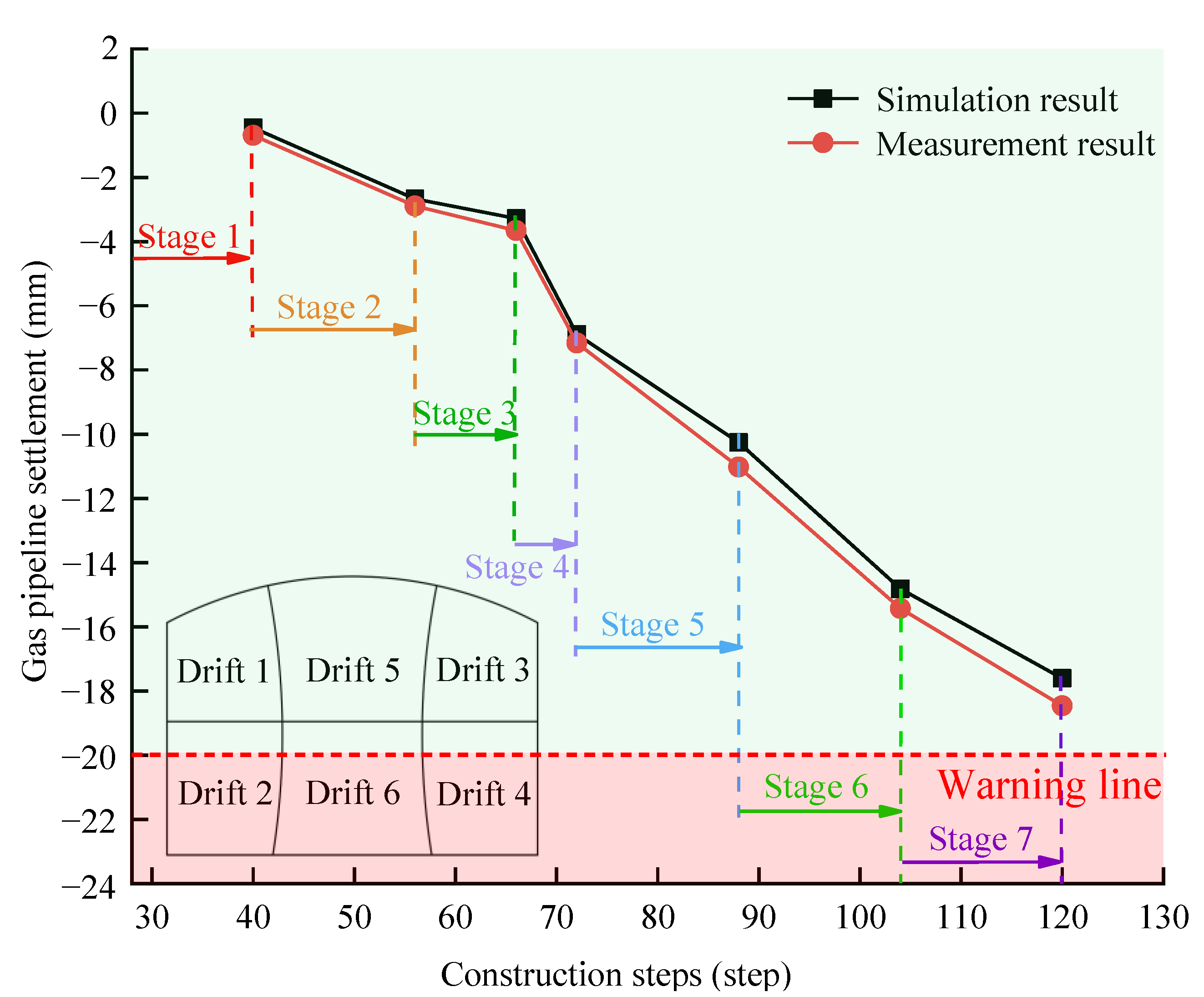
| Stratum | Thickness (m) | Unit Weight (kN/m3) | Young’s Modulus (MPa) | Poisson’s Ratio | Cohesion (kPa) | Angle of Friction (°) |
|---|---|---|---|---|---|---|
| Backfill | 3.6 | 19 | 10 | 0.36 | 3 | 36 |
| Round gravel | 2.7 | 20 | 25 | 0.35 | 0 | 36 |
| Silty sand | 5.9 | 20 | 24 | 0.32 | 0 | 31 |
| Gravelly sand | 2.0 | 20.7 | 25 | 0.30 | 0 | 34 |
| Silty clay | 35.8 | 19.8 | 18 | 0.30 | 37 | 16 |
| Grout | 2.0 | 21 | 52 | 0.23 | 90 | 36 |
| Type | Unit Weight (kN/m3) | Young’s Modulus (MPa) | Poisson’s Ratio |
|---|---|---|---|
| Primary support | 19 | 21 | 0.30 |
| Secondary lining | 25 | 30 | 0.17 |
| Partition wall | 19 | 21 | 0.30 |
| Gas pipeline | 7.3 | 160 | 0.30 |
| Scheme | Grouting Reinforcement Form | Grouting Reinforcement Range (m) | Step Distances of Tunneling (m) |
|---|---|---|---|
| Scheme 1 | Semi-section grouting | 2.0 | 6.0 |
| Scheme 2 | Full-section grouting | 2.0 | 6.0 |
| Scheme 3 | Without grouting | 2.0 | 6.0 |
| Scheme 4 | Semi-section grouting | 1.0 | 6.0 |
| Scheme 5 | Semi-section grouting | 1.5 | 6.0 |
| Scheme 6 | Semi-section grouting | 2.5 | 6.0 |
| Scheme 7 | Semi-section grouting | 2.0 | 2.0 |
| Scheme 8 | Semi-section grouting | 2.0 | 4.0 |
| Scheme 9 | Semi-section grouting | 2.0 | 8.0 |
| Grouting Form | Simulated Maximum Settlement (mm) | Fitted Maximum Settlement (mm) | The Difference between Simulated and Fitted Maximum Settlement (mm) | Offset (mm) | Settlement Trough Width (mm) |
|---|---|---|---|---|---|
| Full-section grouting | 11.06 | 10.57 | 0.49 | −0.09 | 6.32 |
| Semi-section grouting | 18.23 | 17.15 | 1.08 | −0.14 | 6.63 |
| Without grouting | 26.17 | 24.63 | 1.54 | −0.25 | 7.31 |
| Grouting Range (m) | Simulated Maximum Settlement (mm) | Fitted Maximum Settlement (mm) | The Difference between Simulated and Fitted Maximum Settlement (mm) | Offset (mm) | Settlement Trough Width (mm) |
|---|---|---|---|---|---|
| 1.0 | 19.55 | 18.64 | 0.91 | −0.25 | 5.48 |
| 1.5 | 19.01 | 18.44 | 0.57 | −0.18 | 5.71 |
| 2.0 | 18.23 | 17.15 | 1.08 | −0.14 | 6.63 |
| 2.5 | 12.41 | 11.20 | 1.21 | −0.08 | 7.02 |
| Step Distances of Tunneling (m) | Simulated Maximum Settlement (mm) | Fitted Maximum Settlement (mm) | The Difference between Simulated and Fitted Maximum Settlement (mm) | Offset (mm) | Settlement Trough Width (mm) |
|---|---|---|---|---|---|
| 2.0 | 12.23 | 10.89 | 1.34 | −0.19 | 7.08 |
| 4.0 | 13.62 | 12.25 | 1.37 | −0.15 | 6.95 |
| 6.0 | 18.23 | 17.15 | 1.08 | −0.14 | 6.63 |
| 8.0 | 23.16 | 22.86 | 0.30 | −0.13 | 6.36 |
Disclaimer/Publisher’s Note: The statements, opinions and data contained in all publications are solely those of the individual author(s) and contributor(s) and not of MDPI and/or the editor(s). MDPI and/or the editor(s) disclaim responsibility for any injury to people or property resulting from any ideas, methods, instructions or products referred to in the content. |
© 2023 by the authors. Licensee MDPI, Basel, Switzerland. This article is an open access article distributed under the terms and conditions of the Creative Commons Attribution (CC BY) license (https://creativecommons.org/licenses/by/4.0/).
Share and Cite
Zhang, X.; Liang, C.; Huang, S.; Xu, Y. Gas Pipeline Response to Underlying Straight-Wall Arch Tunnel Construction. Buildings 2023, 13, 2661. https://doi.org/10.3390/buildings13102661
Zhang X, Liang C, Huang S, Xu Y. Gas Pipeline Response to Underlying Straight-Wall Arch Tunnel Construction. Buildings. 2023; 13(10):2661. https://doi.org/10.3390/buildings13102661
Chicago/Turabian StyleZhang, Xu, Chiyu Liang, Shimin Huang, and Youjun Xu. 2023. "Gas Pipeline Response to Underlying Straight-Wall Arch Tunnel Construction" Buildings 13, no. 10: 2661. https://doi.org/10.3390/buildings13102661
APA StyleZhang, X., Liang, C., Huang, S., & Xu, Y. (2023). Gas Pipeline Response to Underlying Straight-Wall Arch Tunnel Construction. Buildings, 13(10), 2661. https://doi.org/10.3390/buildings13102661





